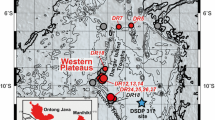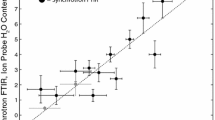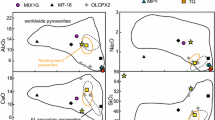Abstract
To investigate the first melts of the mantle wedge in subduction zones and their relationship to primitive magmas erupted at arcs, the compositions of low degree melts of hydrous garnet lherzolite have been experimentally determined at 3.2 GPa over the temperature range of 925–1150 °C. Two starting compositions with variable H2O contents were studied; a subduction-enriched peridotite containing 0.61% Na2O, 0.16 K2O% (wt%) with 4.2 wt% H2O added (Mitchell and Grove in Contrib Mineral Petrol 170:13, 2015) and an undepleted mantle peridotite (Hart and Zindler in Chem Geol 57:247–267, 1986) with 14.5% H2O added (Till et al. in Contrib Mineral Petrol 163:669–688, 2012). Saturating phases include olivine, orthopyroxene, clinopyroxene, garnet and rutile. Melting extent is tracked from near solidus (~ 5 wt%) to 25 wt%, which is close to or beyond the point where clinopyroxene and garnet are exhausted. The beginning of melting is a peritectic reaction where 0.54 orthopyroxene + 0.17 clinopyroxene + 0.13 garnet react to produce 1.0 liquid + 0.88 olivine. The melt production rate near the solidus is 0.1 wt% °C−1 and increases to 0.3 wt% °C−1 over the experimentally studied interval. These values are significantly lower than that observed for anhydrous lherzolite (~ 1 wt% °C−1). When melting through this reaction is calculated for a metasomatized lherzolite source, the rare earth element characteristics of the melt are similar to melts of an eclogite, as well as those observed in many subduction zone magmas. Moreover, since rutile is stable up to ~ 8 wt% melting, the first melts of a hydrous lherzolite source could also show strong high field strength element depletions as is observed in many subduction zone lavas. The silicate melts measured at the lowest temperatures and melting extents (< 10 wt%) are high silica andesites (56–60 wt% SiO2) and contain very low Ca/Al and high alkalis. These deep low degree andesitic melts, if added to experimentally produced hydrous liquids from melting (20–25 wt%) of harzburgite residues at shallow pressures (1.0–1.2 GPa, Mitchell and Grove in Contrib Mineral Petrol 170:13, 2015), can match the compositional characteristics of primitive natural basaltic andesite and magnesian andesite lavas found globally in arcs. In addition to a silicate melt phase, there is a small amount of silicate dissolved in the H2O supercritical fluid that coexists with the silicate liquid and solids in our experiments. The composition of this fluid is in equilibrium with the Mg-rich minerals and it is granitic. The results presented here are used to develop a model for producing hydrous arc magmas. We hypothesize that mantle wedge melting produced by the flux of hydrous fluid from the slab occurs over a range of depths that begins at the base of the mantle wedge and ends at shallow mantle depths. These melts ascend and remain isolated until they mix in the shallow, hottest part of the mantle wedge. In this melting scenario, the metasomatic “slab melt” contributions to arc magmas is small (~ 5 wt%), but its effect on the alkali, REE and incompatible trace element budget of the derivative magmas is large and able to reproduce the trace elemental characteristics of the primitive andesites. Higher proportions of slab or sediment melt do not resemble primitive high magnesian arc andesites and basaltic andesites.













Similar content being viewed by others
References
Armstrong JT (1995) CITZAF—a package of correction programs for the quantitative electron microbeam X-ray analysis of thick polished materials, thin-films, and particles. Microbeam Anal 4:177–200
Baker MB, Stolper E (1994) Determining the composition of high-pressure mantle melts using diamond aggregates. Geochim Cosmochim Acta 58:2811–2827
Behn MD, Kelemen PB, Hirth G, Hacker BR, Massonne HJ (2011) Diapirs as the source of the sediment signature in arc lavas. Nat Geosci 4:641–646. https://doi.org/10.1038/ngeo1214
Boyd FR, England JL (1960) Apparatus for phase equilibrium studies at pressures up to 50 kilobars and temperatures up to 1750 °C. J Geophys Res 65:741–748
Brown SM, Behn MD, Grove TL (2019) The myth of garnet signatures and the origin of plagioclase signatures in mid-ocean ridge basalts. J Geophys Res (submitted)
Bryant JA, Yogodzinski GM, Churikova TG (2011) High-Mg# andesitic lavas of the Shisheisky Complex, Northern Kamchatka: implications for primitive calc-alkaline magmatism. Contrib Mineral Petrol 161:791–810. https://doi.org/10.1007/s00410-010-0565-4
Davies JH, Stevenson DJ (1992) Physical model of source region of subduction zone volcanics. J Geophys Res 97:2037–2070
Falloon TJ, Danyushevsky LV (2000) Melting of refractory mantle at 1.5, 2 and 2.5 GPa under, anhydrous and H2O-undersaturated conditions: implications for the petrogenesis of high-Ca boninites and the influence of subduction components on mantle melting. J Petrol 41:257–283
Gaetani GA, Grove TL (1998) The influence of water on melting of mantle peridotite. Contrib Mineral Petrol 131:323–346
Gaetani GA, Grove TL (2003) Experimental constraints on melt generation within the mantle wedge. In: Eiler JM (ed) Geophysical monograph 138: inside the subduction factory, vol 136. American Geophysical Union. Washington, D.C., pp 107–134
Gill JB (1981) Orogenic andesites and plate tectonics. Springer, New York
Green DH (1973) Experimental melting studies on a model upper mantle composition at high-pressure under water-saturated and water-undersaturated conditions. Earth Planet Sci Lett 19:37–53
Green DH (1976) Experimental testing of “equilibrium” partial melting of peridotite under water-saturated, high-pressure conditions. Can Mineral 14:255–268
Green DH, Hibberson WO, Kovacs I, Rosenthal A (2010) Water and its influence on the lithosphere-asthenosphere boundary. Nature 467:448–451
Green DH, Hibberson WO, Rosenthal A, Kovacs I, Yaxley GM, Falloon TJ, Brink F (2014) Experimental study of the influence of water on melting and phase assemblages in the upper mantle. J Petrol 55:2067–2096. https://doi.org/10.1093/petrology/egu050
Grove TL, Parman SW, Bowring SA, Price RC, Baker MB (2002) The role of an H2O-rich fluid component in the generation of primitive basaltic andesites and andesites from the Mt. Shasta region, N California. Contrib Mineral Petrol 142:375–396
Grove TL, Chatterjee N, Parman SW, Medard E (2006) The influence of H2O on mantle wedge melting. Earth Planet Sci Lett 249:74–89. https://doi.org/10.1016/j.epsl.2006.06.043
Grove TL, Till CB, Krawczynski MJ (2012) The role of H2O in subduction zone magmatism. In: Jeanloz R (ed) Annual review of earth and planetary sciences, Vol 40. pp 413–439. https://doi.org/10.1146/annurev-earth-042711-105310
Grove TL, Holbig ES, Barr JA, Till CB, Krawczynski MJ (2013) Melts of garnet lherzolite: experiments, models and comparison to melts of ganet pyroxenit and carbonated lherzolite. Contrib Mineral Petrol 166:887–910. https://doi.org/10.1007/s00410-013-0899-9
Hacker BR, Kelemen PB, Behn MD (2011) Differentiation of the continental crust by relamination. Earth Planet Sci Lett 307:501–516. https://doi.org/10.1016/j.epsl.2011.05.024
Halliday AN, Lee D-C, Tommasini S, Davies GR, Paslick CR, Fitton JG, James DE (1995) Incompatible trace elements in OIB and MORB and source enrichment in the sub-oceanic mantle. Earth Planet Sci Lett 133:379–395
Hart SR, Zindler A (1986) In search of a bulk-earth composition. Chem Geol 57:247–267
Hattori KH, Wallis S, Enami M, Mizukami T (2009) Subduction of mantle wedge peridotites: evidence from the Higashi-akaishi ultramafic body in the Sanbagawa metamorphic belt. Island Arc 19:192–207. https://doi.org/10.1111/j.1440-1738.2009.00696.x
Hays JF (1966) Lime–alumina–silica Carnegie Institution of Washington Year Book. pp 234–239
Hoffman AW (1988) Chemical differentiation of the Earth: the relationship between mantle, continental crust, and oceanic crust. Earth Planet Sci Lett 90:297–314
Johannes W et al (1971) An interlaboratory comparison of piston-cylinder pressure calibration using the albite-breakdown reaction. Contrib Mineral Petrol 32:24–38
Kelemen PB, Behn MD (2016) Formation of lower continental crust by relamination of buoyant arc lavas and plutons. Nat Geosci 9:197–205. https://doi.org/10.1038/ngeo2662
Kinzler RJ (1997) Melting of mantle peridotite at pressures approaching the spinel to garnet transition: application to mid-ocean ridge basalt petrogenesis. J Geophys Res 102:853–874
Kushiro I (1968) Compositions of magmas formed by partial zone melting of the Earth’s upper mantle. J Geophys Res 73:619–634
Kushiro I (1972) Effect of water on the composition of magmas formed at high pressures J Petrol 13:311–334
Kushiro I, Walter MJ (1998) Mg–Fe partitioning between olivine and mafic-ultramafic melts Geophys Res L 25:2337–2340
Kushiro I, Syono Y, Akimoto S (1968) Melting of a peridotite nodule at high pressures and high water pressures Journal of Geophysical Research. B, Solid Earth Planets 73:6023–6029
Longhi J (2005) Temporal stability and pressure calibration of barium carbonate and talc/pyrex pressure media in a piston-cylinder apparatus. Am Mineral 90:206–218
Mallik A, Nelson J, Dasgupta R (2015) Partial melting of fertile peridotite fluxed by hydrous rhyolitic melt at 2–3 GPa: implications for mantle wedge hybridization by sediment melt and generation of ultrapotassic magmas in convergent margins. Contrib Mineral Petrol. https://doi.org/10.1007/s00410-015-1139-2
Mandler B, Grove TL (2016) Controls on the stability and composition of amphibole in the Earth’s mantle. Contrib Mineral Petrol. https://doi.org/10.1007/s00410-016-1281-5
Medard E, Grove TL (2008) The effect of H2O on the olivine liquidus of basaltic melts: experiments and thermodynamic models. Contrib Mineral Petrol 155:417–432
Mitchell AL, Grove TL (2015) Melting the hydrous, subarc mantle: the origin of primitive andesites. Contrib Mineral Petrol 170:13. https://doi.org/10.1007/s00410-015-1161-4
Mysen BO (1975) Partitioning of iron and magnesium between crystals and partial melts in peridotite upper mantle. Contrib Mineral Petrol 52:69–76
Mysen BO, Boettcher AL (1975a) Melting of a hydrous mantle: I. Phase relations of natural peridotite at high-pressures and temperatures with controlled activities of water, carbon-dioxide, and hydrogen. J Petrol 16:520–548
Mysen BO, Boettcher AL (1975b) Melting of a hydrous mantle:II. Geochemistry of crystals and liquids formed by anatexis of mantle peridotite at high pressures and high temperatures as a function of controlled activities of water, hydrogen and carbon dioxide. J Petrol 16:549–593
Nehru CE, Wyllie PJ (1975) Compositions of glasses from St. Paul’s peridotite partially melted at 20 kilobars. J Geol 83:455–471
Poldervaart A (1955) Chemistry of the earth’s crust. Geol Soc Am Spec Pap 2:119–144
Roeder P, Emslie R (1970) Olivine-liquid equilibrium. Contrib Mineral Petrol 29:275–289
Shaw DM (2006) Trace elements in magmas: a theoretical treatment. Cambridge University Press, Cambridge
Tatsumi Y, Ishizaka K (1982) Origin of high-magnesian andesites in the Setouchi Volcanic Belt, Southwest Japan. 1. Petrographical and chemical characteristics. Earth Planet Sci Lett 60:293–304. https://doi.org/10.1016/0012-821x(82)90008-5
Tatsumi Y, Hamilton DL, Nesbitt RW (1986) Chemical characteristics of fluid phase released from a subducted lithosphere and origin of arc magmas—evidence from high-pressure experiments and natural rocks. J Volcan Geotherm Res 29:293–309
Tenner TJ, Hirschmann MM, Humayun M (2012) The effect of H2O on partial melting of garnet peridotite at 3.5 GPa. Geochem Geophys Geosyst. https://doi.org/10.1029/2011gc003942
Till CB (2017) A review and update of mantle thermobarometry for primitive arc magmas. Am Mineral 102:931–947. https://doi.org/10.2138/am-2017-5783
Till CB, Carlson RW, Grove TL, Wallis S, Mizukami T (2009) A missing link in understanding mantle wedge melting, Higashi-akaishi peridotite, Japan EOS, AGU Fall Meeting abstract V44A-03
Till CB, Grove TL, Withers AC (2012) The beginnings of hydrous mantle wedge melting. Contrib Miner Petrol 163:669–688. https://doi.org/10.1007/s00410-011-0692-6
Toplis MJ (2005) The thermodynamics of iron and magnesium partitioning between olivine and liquid: criteria for assessing and predicting equilibrium in natural and experimental systems. Contrib Mineral Petrol 149:22–39
Ulmer P (1989) The dependence of the Fe2+–Mg cation-partitioning between olivine and basaltic liquid on pressure, temperature and composition—an Experimental-Study to 30 Kbars. Contrib Mineral Petrol 101:261–273
Walter MJ (1998) Melting of garnet peridotite and the origin of komatiite and depleted lithosphere. J Petrol 39:29–60
Watson EB, Wark DA, Price JD, Van Orman JA (2002) Mapping the thermal structure of solid-media pressure assemblies. Contrib Mineral Petrol 142:640–652
White BS, Wyllie PJ (1992) Solidus reactions in synthetic lherzolite–H2O–CO2 from 20–30 kbar, with applications to melting and metasomatism. J Volcan Geotherm Res 50:117–130. https://doi.org/10.1016/0377-0273(92)90040-k
Acknowledgements
This research was supported by NSF Grants EAR 1551321 to TLG and EAR 1447342 to CBT. We thank Peter Ulmer and an anonymous reviewer for their constructive reviews, along with Othmar Müntener for his editorial handling of the manuscript.
Author information
Authors and Affiliations
Corresponding author
Additional information
Communicated by Othmar Müntener.
Publisher's Note
Springer Nature remains neutral with regard to jurisdictional claims in published maps and institutional affiliations.
Electronic supplementary material
Below is the link to the electronic supplementary material.
Rights and permissions
About this article
Cite this article
Grove, T.L., Till, C.B. H2O-rich mantle melting near the slab–wedge interface. Contrib Mineral Petrol 174, 80 (2019). https://doi.org/10.1007/s00410-019-1615-1
Received:
Accepted:
Published:
DOI: https://doi.org/10.1007/s00410-019-1615-1




